Gregor Johan Mendel did studies of genetics using the Pisum sativan (garden peaces).
He was trying to find the laws that govern the passage of characters from one generation to another.
He established that Pisum sativum had the following advantages over other species:-
1. They were several varieties available which had quite district characteristics.
2. The plants were easy to cultivate
3. The reproductive structures were enclosed by the petals, this made the plant self pollinating and hence producing varieties of the some characteristics (pure breading).
4. Artificial cross – breeding between varieties was possible and resulting hybrids were confertile.
Mono hybrid inheritance and the principle of segregation:-
-
Monohybrid inheritance is a pattern of inheritance which involves two contrasting variations of only one characteristic.
Example:
Tall Vs short (height).
Red Vs White (colour).
Rough Vs Smooth (texture).
Glossary of common genetic terms:-
- Gene -The basic unit of inheritance for a given characteristic.
- Allele – One of number of alternative forms of the same gene responsible for determining contrasting characteristics e.g. A or a (pared genes).
edu.uptymez.com
3. Locus – Position of an allele within a DNA molecule. Alleles of one gene are on one locus.
4. Homozygous – The diploid condition in which the alleles at a given locus are identical e.g. AA or aa.
5. Heterozygous – The diploid condition in which the alleles at a given locus are different e.g. Aa.
6. Phenotype – The observable characteristics of an individual usually resulting from the interaction between the genotype and the environment in which development occurs e.g. Red, blue.
7. Genotype – The genetic constitution of an organism with respect to the allele under consideration e.g. AA2, A2, or did.
8. Dominant – The allele which influence the appearance of the phenotype even in the presence of an alternative allele e.g. A
9. Recessive – The allele which influence the appearance of the phonotype only be or in the presence of another identical allele e.g. a
10. F1 generation – The generation produced by crossing homozygous parents.
11. F2 generation – The generation produced by crossing two F1 organisms.
Basic Monohybrid ratio
This is the phenotypic ratio contained in the F2 generation of the original pure parents.
The ratio is always 3:1
Mendel’s experiment and the Monohybrid ratio
- In one of his experiments, Mendel crossed a red flowered plant from a pure line with a white flowered plant also from a pure line. Al the resulting F1 plants had red flowers.
- When the F1 members were selfed, the resulting F2 were a mixture of red and white phenotypes in the approximate ratio of 3:4.
-
This is the basic monohybrid ratio obtained from a cross between two heterozygous individuals.
Illustration:-
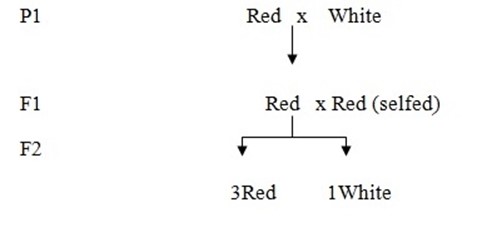
edu.uptymez.com
Non coding DNA.
Though human DNA contains large number of genes, the problem is about 95% of the DNA appears to have no obvious function because it is non – coding. In other words does not code for proteins or RNA.
(i) The factor for redness was dominant over that for whiteness which was red.
(ii) The factor for whiteness was present in the F1 though not expressed effect was obscured by the factor for redness.
(iii) The characteristic red and the characteristic white remained unchanged. I.e.: There was no an intermediate colour.
(iv) Each characteristic is controlled by a pair of factors that segregate during gamete formation.
-
This observation, suggested to Mendel the formulation of his first law “the law of segregation.”
Assumptions:–
(i) Let ‘R’ be factor redness and ‘r’ factor for whiteness.
(ii) Let ‘R’ dominate ‘r’ so that when the two are together, only R is expressed.
(iii)Let each character be controlled by a pair of factors that segregate gametes formation.
Consider the following cross:-
Parental phenotypes Pure breeding Red flower x Pure bleeding White flower
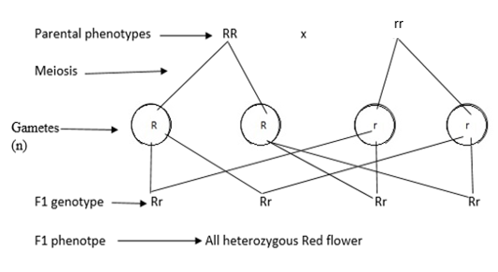
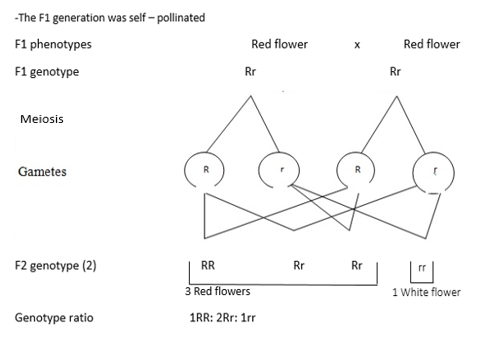
Phenotypic ratio 3Red : 1White
Mendel’s 1st law of inheritance (Law of segregation)
The law states that:-
“The characteristics of an organism are determined by internal factors which occur in pairs. Only one of a pair of such factors can be represented in a single gamete.
Meiotic explanation of Mendel’s first law.
- Although Mendel knew nothing about Meiosis, but his first law is explained by Meiosis as follows:-
- During Meiosis, the paired homologous chromosomes, separate from each other as a result of which the gametes receive only one type of chromosome instead of the normal two.
- Alleles also occur in pairs at the homologous chromosomes, thus separation of homologous chromosomes occurs currently with the separation of alleles.
-
Thus, there is similarity between separation of homologues chromosomes in Meiosis and segregation of Mendelian factors.
We know that Mendel’s factors are specific portion of a chromosome called genes. We also know that the process which produces gametes with only one of each pairs of factors is Meiosis. On the basis of his results, Mendel had effectively predicted the existence of genes and Meiosis.
Methods used to solve Mendelian problems:-
(a) Algebraic method.
(b) Punnet square/chequer board method.
(c) Mendelian crosses/genetics diagrams
(A) Algebraic method
– Consider a cross between two tall plants both heterozygous for height.
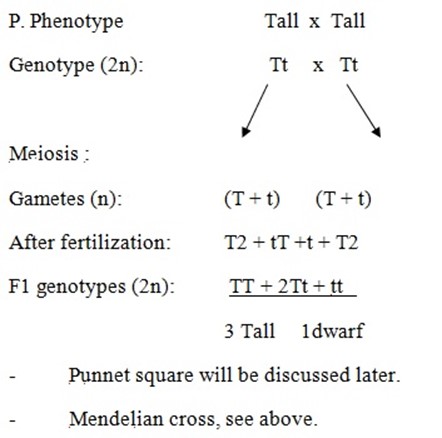
Symbols used in genetics:-
- In genetics any symbol can be used to represent any characteristics provided it is defined.
-
However, it is common that a dominant characteristic is represented by the first latter of its name. Eg. R for red, T for tall, G for green etc. The characteristics will take the lower case letter of the dominant one e.g r white where R red is dominant to white. The symbol P1 stands for parents and F1 and F2 are filial generations 1 and 2respectively
Example: One of the causes of dwafirsm in man is the inheritance of dominant gene D. The allele for a normal height is d, Given that the genotype for Kijeba a man suffering from dwafirsm is Dd, work out the genotype and phenotype rations of the offspring if he marries.
(a) A normal woman
(b) A dwarf woman
Solution:-
Given: D – allele for dwarfness
d – allele for tallness
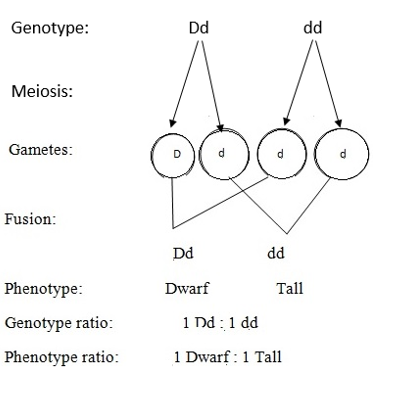
(b) If he marries, the genotypes and phenotypes of there child will depend on the genotype of the woman.
(c) If she is homozygous tall, then half the offspring will be phenotype tall and the half short(dwarf) above reveals.
If she is homozygous dwarf, then the products will be.
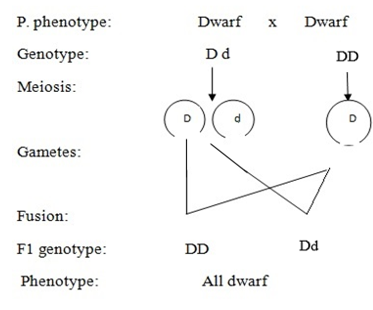
P. phenotype: Dwarf x Dwarf
Genotype: D d D d
The genotype ratio will be 1 DD: 1 Dd
If she is heterozygous dwarf, then the products will be.
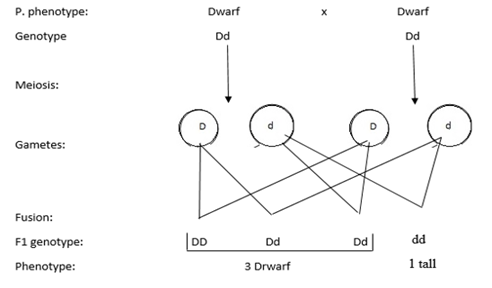
Genotype ratio is 1DD : 2Dd: 1dd
Phenotype ratio is 3 Dwarf : 1 tall
BACK CROSS AND TEST CROSS
- Back cross – This is a cross between an organism and either of its parents.
-
Test cross – This is a cross between an experimental organism with a dominant phenotype and that of a recessive phenotype, of its parent so as to determine the genotype of that experimental organism.
Explanations:-
One common genetic problem is that an organism which shows a dominant character has two possible genotypes.
Example
A plant producing seeds with round coats could either be homozygous dominant (RR) heterozygous (Rr). The appearance of the seeds (phenotype) is identical in both cases. However it is often necessary to determine the genotype accurately.
This involves the use of a technique known as Test mass in which an organisms is unknown genotype is crossed with the one whose genotype is accurately known.
A genotype which can positively be identified from its phenotype alone is one which shows recessive features.
In the case of the seed coast, any pea seed with a linked coast must have the genotype “rr”. By crossing the dominant character, the unknown genotype can be identified.
Let R = allele for round seeds
R = allele for wrinkled seeds
If the plant producing round seeds have the genotype RR.
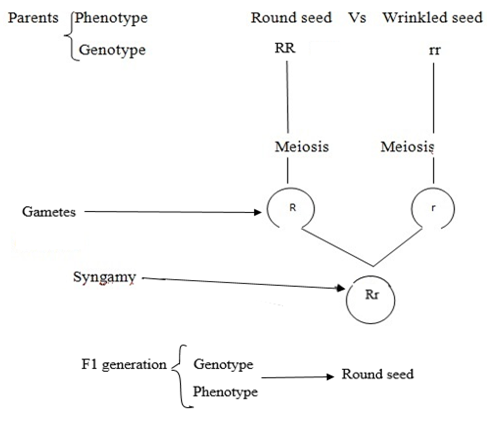
Conclusion: The only possible offspring are plants which produce round seeds, thus the unknown genotype is RR.
If the plant producing round seeds have the genotype Rr.
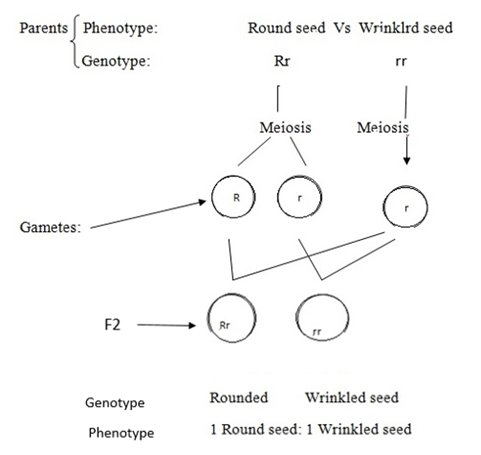
edu.uptymez.com
This 1:1 ratio is the monohybrid test cross ratio obtained from a cross investigation between heterozygous dominant and a homozygous recessive.
Questions
1. If a pure strain of mice with brown-coloured fur are allowed to breed with a pure of mice with grey-coloured fur, they produce offspring with brown-coloured fur. If F1 mice are allowed to interbreed
they produce an F2 generation with fur coloured in proportional of three brown-coloured to one grey.
Explain their result fully.
What would be the results of meeting a brown – coloured heterozygote from the generation with the original grey – coloured parent?
Answer:-
Let: B represents brown fur (dominant)
b represents grey fur (recessive)
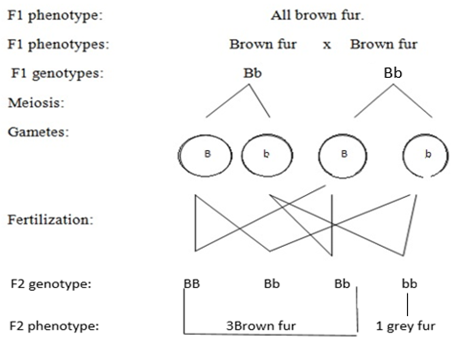
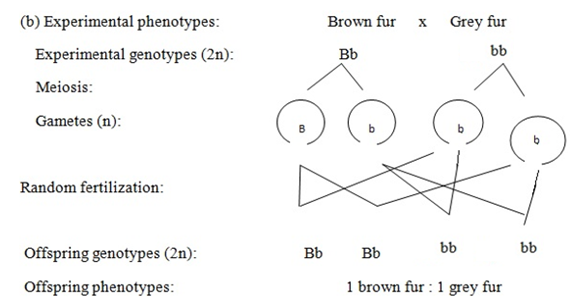
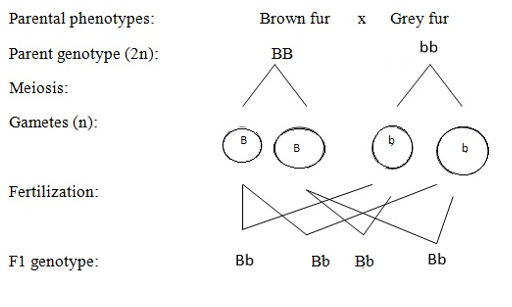
F1 phenotype. All brown fur
NON – MONOHYBRID INHERISTANCE
This is a pattern of inheritance which involves more than one character. These may be two three etc.
Dihybrid inheritance and Mendel’s Law of Independent assortment.
Dihybrid inheritance is the pattern of inheritance which involves inheritance of two characters simultaneously.
In one of his experiments Mandel investigated the inheritance of the seed shape (size Vs Wrinkled) and seed colour (Yellow Vs green) at the same time. He knew from the monohybrid crosses that the round seeds were dominant to wrinkled ones and yellow seeds were dominant to green. He chose to cross plants with both dominant seed (round and yellow) with one that were recessive for both (Wrinkled and green).
The F1 generation yield plants all of which produced round, yellow seeds – hard surprising as these are two dominant features.
F1 seeds were planted and then allowed to self pollinate. The resulting members were a mixture of phenotype in the following proportions:
315 Round yellow (Two dominant features).
701 Wrinkled yellow (recessive and Dominant).
108 Round green (Dominant and recessive).
32 Wrinkled green (Two recessive features).
- Those numbers represent an appropriate ratio of 9:3:3:1. This is the basic dihybrid ratio.
-
In a dihybrid cross, characteristic behaves independently of the other i.e Each characteristics behaves as if it is in the monohybrid cross.
Now, treating each characteristic separately we have:-
(a) Considering seed texture (Ignore colour)
Round Winkled
315 + 108 101 + 32
423 133
133 133
3 : 1
(b) Considering colour (Ignore seed texture)
Yellow Green
315 + 101 108 + 32
416 140
140 140
= 3 : 1
- Thus, in the F2 generation of a dihybrid cross each characteristics, has a phenotype ratio of 3:1
-
The binomial of the two ratios renders.
(3:1) (3:1) = 9:3:3:1
Thus, the dihybrid ratio is a binomial expression of two bases monohybrid rations.
Genetic representation of the dihybrid cross:-
Let R = allele for round seed
r = allele for wrinkled seed
G = allele for yellow seed
g = allele for green seed.
Parents Phenotype: round yellow seed Vs wrinkled green seed
Genotype: RRGG rrgg
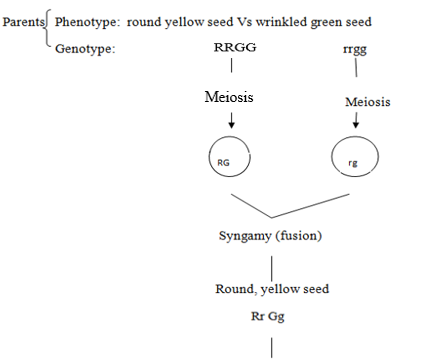

edu.uptymez.com
Punnet square to show the fusion of gametes:-
| Gamets | RG | Rg | rG | rg |
| RG | RRGG | RRGg | RrGG | RrGg |
| Rg | RRGg | RRgg | RrGg | Rrgg |
| rG | RrGG | RrGg | rrGG | rrGg |
| rg | RrGg | Rrgg | rrGg | rrgg |
edu.uptymez.com
rrGg = Wrinkled, Yellow seed – 2
rrgg = Wrinkled, green seed – 1
rrGG = Wrinkled, Yellow seed – 1
Hence the ratio 9:3:3:1
How to calculate the genotype and phenotype ratio of a dihybrid cross.
There are two alternative ways:-
(a) By counting the number of boxes on the punnet square containing the genotype and phenotype of interest.
(b) Using a method based on the probability principle that:-
“The chances that a number of independent events will occur together, is square to the product of the chances that each event occur separately.”
From above example, there is a1 in 4 chance of any gamete containing any of the F2 allele combination shown above.
From a consideration of monohybrid inheritance where ¾ of the F2 phenotypes show the dominant allele and ¼ the recessive allele, the probability of the four alleles appearing in any F2 phenotype as
follows:
Round (dominant) ¾.
Yellow (dominant) ¾.
Wrinkled (Recessive) ¼.
Green (Recessive) ¼.
Hence the probability of the following combinations of alleles appearing in the F2 phenotypes is as follows:-
Round and Yellow = ¾ x ¾ = 9/16.
Round and green = ¾ x ¼ = 3/16.
Round and yellow = ¼ x ¾ = 3/ 16.
Wrinkled and green = ¼ x ¼ = 1/16.